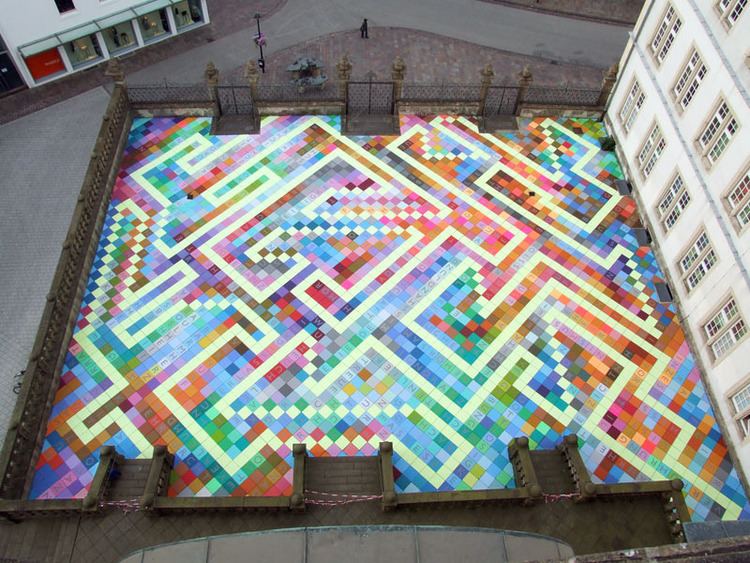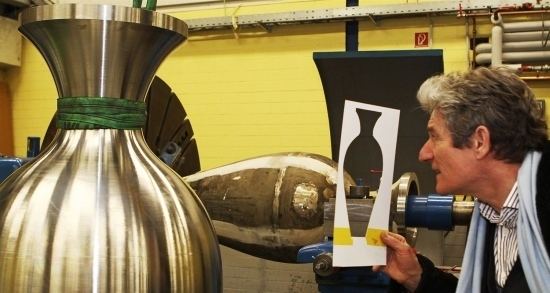Name Horst Glasker Role Artist | ||
 | ||
Education Kunstakademie Dusseldorf | ||
Horst Gläsker (born March 21, 1949 in Herford, Germany) is a German artist. His work is a symbiosis of music, dance, theatre, drawing, painting, sculpture, installation and architecture.
Contents
Development

From 1963 to 1966 Horst Gläsker did an apprenticeship as a showcase designer and in the following years up to 1968 he worked as poster artist. From 1970 to 1973 he visited a course of lectures and did the university-entrance diploma. Parallel to this he was active as a musician. During the 60s he and his 4 brothers were in a dance combo and in the 70s he was involved with diverse Kraut-rock groups of the era. At the end of the 70s he began to build sound sculptures and to make music performances. From 1973 to 1979 he studied at the Kunstakademie Düsseldorf, with Lambert Maria Wintersberger, Gerhard Richter and Karl Otto Götz. 1975 he lived 1 year in a mountain shelter in the Toscana where he painted landscapes and portraits and grappled intensely with the effect of colours. After that he developed a painture out of his colour palettes, collected old Persian carpets from the rubbish and painted psychedelic colour patterns on its ornaments which had the consequence, that Gerhard Richter expelled him from his class. After that Gläsker worked alone in an abandoned room, belonging to the suspended professor Joseph Beuys, who had been dismissed without notice by Johannes Rau, the minister of science at that time, because he indiscriminately admitted all people who applied to the academy. Later Gläsker became master student of Karl Otto Götz (professor of Sigmar Polke, Franz Erhard Walther and others).
Work

Art scientists have linked Horst Gläsker with the category “Individual Mythology” coined by Harald Szeemann or grouped him with the “Junge Wilde” ("wild youth"). The closest definition of his art is perhaps the idea of the “Gesamtkunstwerk”. Harald Falckenberg (see: Collection Falckenberg), the Hamburger art collector, businessman, lawyer and art theorist, described him as ”bird of paradise and holy fool” and saw him in a reference to the newer development of the “pictorial turn” and the ancient tradition of the grotesque. Besides the relation of his art to music, there is the connection with architecture. This began in the 80s with space filling painting on wallpapers, self built and repainted architectural pieces, and space frame works like columns, candelabra, cupolas, and pavilions etc. Following on from that there were numerous “art in architecture” applications and projects, for example murals, mosaics, fountains and floor designs. The art theorist and curator Manfred Schneckenburger named Gläsker, in relation to his carpet and wallpaper paintings, the European founder of the Pattern Art and wrote that he developed his own particular new, idea of the ornament, “as if the hard verdict of Adolf Loos “ornament is a crime” had never existed".
Life

Horst Gläsker lives and works in Düsseldorf, Germany. He has an artist family. He works organizationally and artistically together with his wife Margret Masuch-Gläsker. Their two common children are Louis Gläsker (artist, musician, writer, and filmmaker) and Cecilia Gläsker (filmmaker, camerawoman and photographer).
Teachings
Individual exhibitions (selection)
Joint exhibitions (selection)
Public commissions - Art in Architecture (selection)
Performances and concerts with Sound Sculptures (selection)
Pedal-Organ-Carpet-Concerts
Table Concerts
Living Pictures
